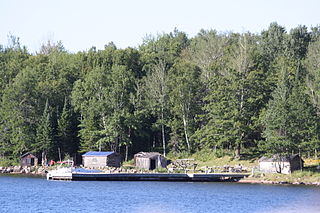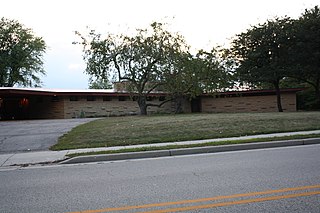
The Sokaogon Chippewa Community, or the Mole Lake Band of Lake Superior Chippewa, is a band of the Lake Superior Chippewa, many of whom reside on the Mole Lake Indian Reservation, located at 45°29′52″N88°59′20″W in the Town of Nashville, in Forest County, Wisconsin. The reservation is located partly in the community of Mole Lake, Wisconsin, which lies southwest of the city of Crandon.

The Villa Louis is a National Historic Landmark located on St. Feriole Island, in Prairie du Chien, southwestern Wisconsin. The villa and estate are a historical museum operated by the Wisconsin Historical Society. The site has been restored to its appearance during the late 19th century, when it was the estate of the prominent H. Louis Dousman family, descendants of a fur trader and entrepreneur.

Manitou Camp is a logging and fishing camp started in the 1890s on Manitou Island, part of the Apostle Islands National Lakeshore. Today, as historically, Manitou Camp is used as a campground and as a facility for fishing. It has been listed on the National Register of Historic Places since 1983 and is owned by the National Park Service.

Apple River Fort, today known as the Apple River Fort State Historic Site, was one of many frontier forts hastily completed by settlers in northern Illinois and southern Wisconsin following the onset of the 1832 Black Hawk War. Located in present-day Elizabeth, Illinois, United States, the fort at the Apple River settlement was built in less than a week. It was one of the few forts attacked during the war and the only one attacked by a band led by Black Hawk himself. At the Battle of Apple River Fort, a firefight of about an hour ensued, with Black Hawk's forces eventually withdrawing. The fort suffered one militia man killed in action, and another wounded. After the war, the fort stood until 1847, being occupied by squatters before being sold to a private property owner who dismantled the building.

The University of Wisconsin Armory and Gymnasium, also called "the Red Gym" or “Bowser’s Castle,” is a building on the campus of University of Wisconsin–Madison. It was originally used as a combination gymnasium and armory beginning in 1894. Designed in the Romanesque revival style, it resembles a red brick castle. It is situated on the shores of Lake Mendota, overlooking Library Mall, and adjacent to Memorial Union.

Harold C. Bradley House, also known as Mrs. Josephine Crane Bradley Residence, is a Prairie School home designed by Louis H. Sullivan and George Grant Elmslie. It is located in the University Heights Historic District of Madison, Wisconsin, United States. A National Historic Landmark, it is one of just a few residential designs by Sullivan, and one of only two Sullivan designs in Wisconsin.

The Namur Historic District, also known as the Namur Belgian-American District, is a historic district in southwestern Door County, Wisconsin. The district includes the community of Namur and a rural landscape extending 3 miles (4.8 km) to its north. It contains one of the nation's highest concentrations of immigrant Belgian and Belgian-American culture, land use, and architecture. It was declared a National Historic Landmark in 1990.

The William B. Tennison is a Chesapeake Bay bugeye built in 1899 and converted to an oyster buy-boat in 1906-07. With the conversion her sail rig was removed and an engine inserted, and is the only surviving example of this conversion. Her construction marks a transition between log construction and plank construction. She is homeported at the Calvert Marine Museum in Solomons, Maryland. The Tennison is reputed to be the second oldest licensed passenger vessel in the United States.

Woodland is a historic house on the grounds of Sam Houston State University in Huntsville, Texas. Built in stages beginning about 1847, it was the residence of Sam Houston from 1847 to 1859. The house is now part of Sam Houston Memorial Museum, and is a National Historic Landmark.

The E. Clarke and Julia Arnold House is a Frank Lloyd Wright designed Usonian home in Columbus, Wisconsin, United States.

Minertown-Oneva, also known as Minertown, in Forest County, Wisconsin is a historic logging camp built in the early 1900s by Wilbur and Henry T. Miner. It's in the vicinity of Carter, Wisconsin.

Regester Log House is a historic log house in Fredericktown, Pennsylvania.

Rungstedlund, also known as the Karen Blixen Museum, is a country house in Rungsted on the Øresund coast just north of Copenhagen, Denmark, notable for its association with the author Karen Blixen, who lived there for most of her life. She was born on the estate in 1885, and returned there after her years in Kenya, chronicled in her book Out of Africa, to do most of her writings. The property is today managed by the Rungstedlund Foundation as a writer's house museum.

St. Joseph's Catholic Church Complex is located in Waukesha, Wisconsin. The church building itself was built in 1888. On October 28, 1983, the complex was added to the National Register of Historic Places for its architectural significance.

The Hadland Fishing Camp is a historic fishing camp in the Apostle Islands of Ashland County, Wisconsin. Built in 1938, the camp is located on the eastern shore of Rocky Island and is part of the Rocky Island Historic District. It was added to the National Register of Historic Places on August 18, 1977.

This is a list of the National Register of Historic Places listings in Forest County, Wisconsin. It is intended to provide a comprehensive listing of entries in the National Register of Historic Places that are located in Forest County, Wisconsin. The locations of National Register properties for which the latitude and longitude coordinates are included below may be seen in a map.
The Trout Point Logging Camp was in operation from the late 19th century to well into the 20th century. Located on Stockton Island near Bayfield, Wisconsin, it was added to the National Register of Historic Places in 1988 and the State Register of Historic Places early the following year.

The Angeline Champeau Rioux House is located in Howard, Wisconsin.

The George, Sr., and Ellen Banta House is located in Menasha, Wisconsin.
























